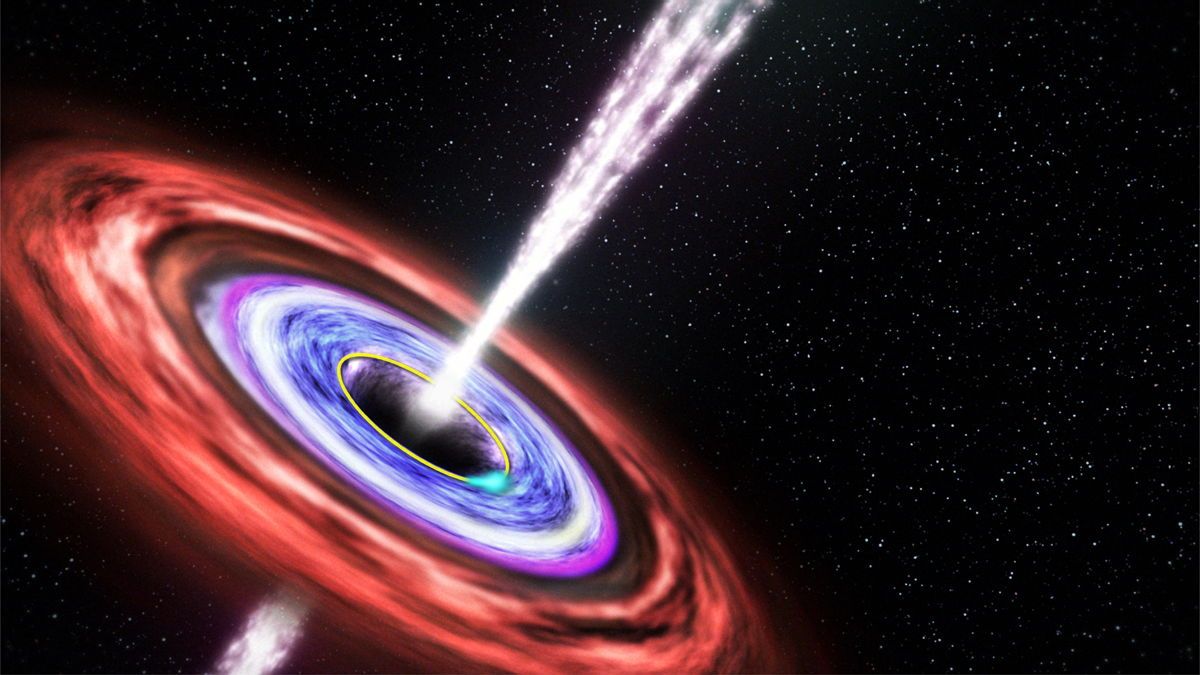Black Holes Spew Out Surprise

Black holes come in a variety of sizes, ranging from 10 times the mass of the sun to a billion times as massive. But new research shows that black holes of completely different masses, ages and locations can produce jets of ionized gas that behave similarly.
"As scientists, we are always seeking universal principles," Rodrigo Nemmen, of NASA's Goddard Space Flight Center in Greenbelt, Md., told SPACE.com.
Nemmen and his colleagues studied a wide variety of black holes in an attempt to compare how efficiently their jets emitted light. "I was very surprised," Nemmen said of the results.
Discovering similarities between ancient supermassive black holes in the center of distant galaxies and baby black holes born as stars collapse should help scientists gain a firmer understanding of these jets.
Cosmic accelerators
Black holes are well known for their ability to pull matter into them. But not all material near a black hole finds itself lost. Some bits of matter just outside the point of no return (called the event horizon) are accelerated away at near-light speeds, creating jets of particles shooting out above and below the black holes.[Photos: Black Holes of the Universe]
"I like to call black holes 'cosmic LHCs,' or very powerful particle accelerators," Nemmen said, referring to the Large Hadron Collider, an underground machine in Switzerland that speeds protons to 99.9999991 percent the speed of light.
Sign up for the Live Science daily newsletter now
Get the world’s most fascinating discoveries delivered straight to your inbox.
When matter is spun away from a black hole in the form of a jet, most of its energy goes into its motion, but some of it is changed into light in the form of gamma-rays. Nemmen and his team studied findings on 293 previously observed black holes and calculated how efficiently the jets converted energy to light. They found that the rate scaled across the range of black holes.
"This was one of the surprises of this work, that this efficiency of conversion of the energy into light is essentially the same for black holes with very different masses, very different ages and completely different environments," Nemmen said.
Black holes are powerful beasts, interesting in and of themselves. But by accelerating ionized gas, they also have the potential to change their environment. Heating up space, they could affect the production of new stars, thereby influencing the galaxy they live in.
"These jets might be powerful agents of creating changes in the host galaxy," Nemmen said.
Scientists still don't have a strong understanding of how these violent particle outflows form. But the fact that the energy efficiency of the jets scales across black holes may help theorists better understand how something that pulls in most particles could shoot away others, and how the outflow of energy may affect surrounding space.
The findings were published online today (Dec. 13) in the journal Science.
Different scales
A baby black hole, created when stars die, and a supermassive black hole are two different monsters. Black hole astronomers tend to focus on one or the other rather than take a holistic approach, according to Nemmen.
But the fact that the two types have such strong similarities in their jets could help scientists understand them even more.
In the end, the two communities of scientists "might be studying manifestations of the same phenomena on different scales," Nemmen said.
Only with the recent availability of telescopes such as Swift Gamma-Ray Burst mission and Fermi Gamma-Ray Space Telescope (launched in 2004 and 2008, respectively) have scientists been able to study black holes and their jets in such detail.
"If it were not for the observations of Fermi and Swift, we would not have been able to do this work," Nemmen said.
Their jets' conversion of energy to light may not be the only thing black holes have in common. Nemmen hopes to study other properties, such as their spectra, or the particular characteristics of their light.
"I think this is the first step in trying to find out how these beasts behave," he said. "The next step is trying to find connections between different types of black holes using other types of observations."
This story was provided by SPACE.com, a sister site to Live Science. Follow SPACE.com on Twitter @Spacedotcom. We're also on Facebook & Google+.













